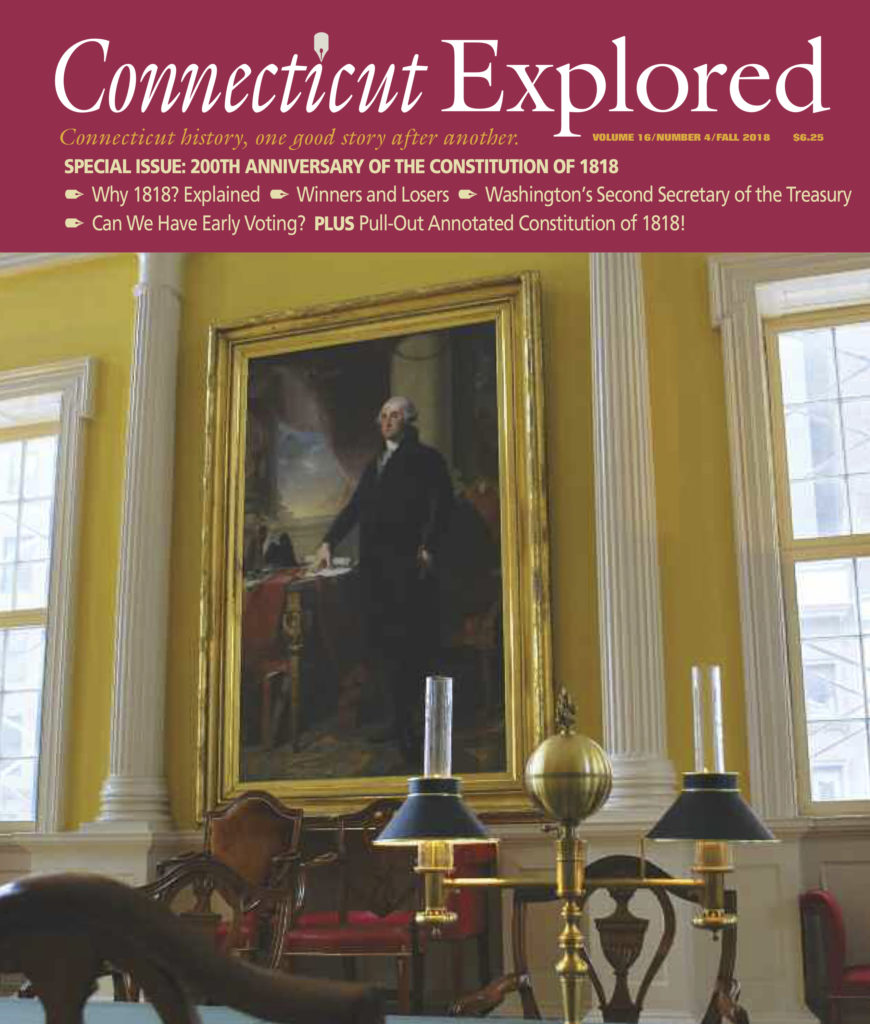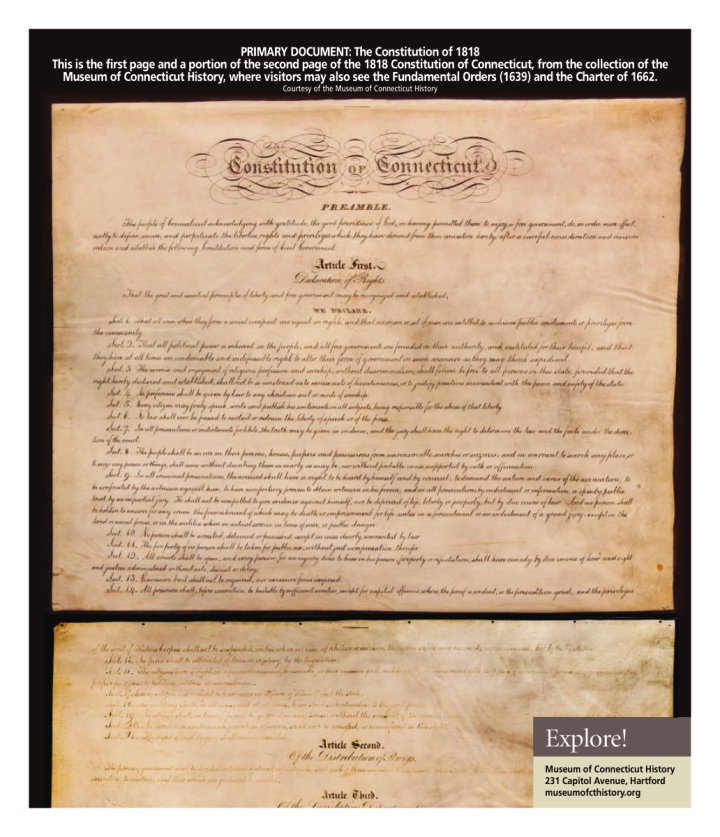 Connecticut History and Constitution of 1818
Connecticut History and Constitution of 1818
Developed by Jim D’Acosta, National Board Certified Teacher, Fairfield Warde High School, January 2019
Handout: Connecticut Explored, Fall 2018
For additional resources, including our 5-part podcast and related stories from earlier issues of the magazine, visit https://www.ctexplored.org/constitution/.
Instructions to Students:
Using
- Excerpts from The Declaration of Independence (1776) (provided below)
- Pull-out annotated copy of Connecticut’s Constitution of 1818 (in the Fall 2018 issue, and HERE)
- Excerpts from The Declaration of Sentiments (1848) (provided below)
Create a CHART comparing language in each document:
1) At the beginning, to whom or to what is thanks given for the establishment of the government?
2) What is the source of human rights?
3) Name some of those rights.
4) What is the government’s job?
5) If the government isn’t doing its job, what do people have the right to do?
6) What is the source of political power?
7) How do citizens demonstrate their consent to laws?
8) List three aggressive, powerful, uncompromising words or phrases.
Compare ideas:
9) Why do the references to God at the beginning of these documents reveal about our society?
10) Identify the document which protects the rights of the most people and explain why.
11) Reflect on the differing language used in question 5 of the chart.
12) Which document is the most radical? Why?
——————————————————————————————————————————-
 Specific to Connecticut’s Constitution of 1818
Specific to Connecticut’s Constitution of 1818
13) Read Article First, Sec. 3, and the annotation. Identify the religious discrimination which was the law in Connecticut before 1818.
14) Read Article First, Sec. 12 and the annotation. Identify the Magna Carta with its year, country, and recognized historical importance and then give an example of the kind of access to courts which this part of Connecticut’s Constitution guarantees.
——————————————————————————————————————————-
Specific to the Fall 2018 issue of Connecticut Explored
15) Read one of the four major articles in this issue:
- The Revolution of 1818, p. 14
- The People’s Governor, p. 20
- The Unfinished Road to Early Voting, p. 26
- What We Got in the constitution of 1818, p. 32
Alone or with your Study Buddy, summarize the article in one or two paragraphs.
Separate and different from your Study Buddy, quote two passages you found interesting. For each one, reflect for a full paragraph: Explain why you found it interesting, relate to it using your personal experienced, and analyze it.
Document Excerpts
Declaration of Independence
July 6, 1776, Philadelphia, Pennsylvania
Thomas Jefferson principle writer
“When in the Course of human events, it becomes necessary for one people to dissolve the political bands which have connected them with another, and to assume among the Powers of the earth, the separate and equal station to which the Laws of Nature and of Nature’s God entitle them, a decent respect to the opinions of mankind requires that they should declare the causes which impel them to the separation.
“We hold these truths to be self-evident, that all men are created equal, that they are endowed by their Creator with certain unalienable Rights, that among these are Life, Liberty and the pursuit of Happiness.
“That to secure these rights, Governments are instituted among Men, deriving their just powers from the consent of the governed.”
Declaration of Sentiments and Resolutions
July 1848, Seneca Falls Convention
written principally by Lucretia Mott and Elizabeth Cady Stanton
“When, in the course of human events, it becomes necessary for one portion of the family of man to assume among the people of the earth a position different from that which they have hitherto occupied, but one to which the laws of nature and of nature’s God entitle them, a decent respect to the opinions of mankind required that they should declare the causes that impel them to such a course.
“We hold these truths to be self-evident: that all men and women are created equal; that they are endowed by their Creator with certain inalienable rights; that among these are life, liberty, and the pursuit of happiness; that to secure these rights governments are instituted, deriving their just powers form the consent of the governed. Whenever any form of Government becomes destructive of these ends, it is the right of those who suffer from it to refuse allegiance to it, and to insist upon the institution of a new government, laying its foundation on such principles, and organizing its powers in such form as to them shall seem most likely to effect their safety and happiness. Prudence, indeed, will dictate that governments long established should not be changed for light and transient causes; and accordingly, all experience hath shown that mankind are more disposed to suffer, while evils are sufferable, than to right themselves, by abolishing the forms to which they are accustomed. But when a long train of abuses and usurpations, pursuing invariably the same object, evinces a design to reduce them under absolute despotism, it is their duty to throw off such government, and to provide new guards for their future security. Such has been the patient sufferance of the women under this government, and such is now the necessity which constrains them to demand the equal station to which they are entitled.
“The history of mankind is a history of repeated injuries and usurpations on the part of man toward woman, having in direct object the establishment of an absolute tyranny over her. To prove this, let facts be submitted to a candid world.”
